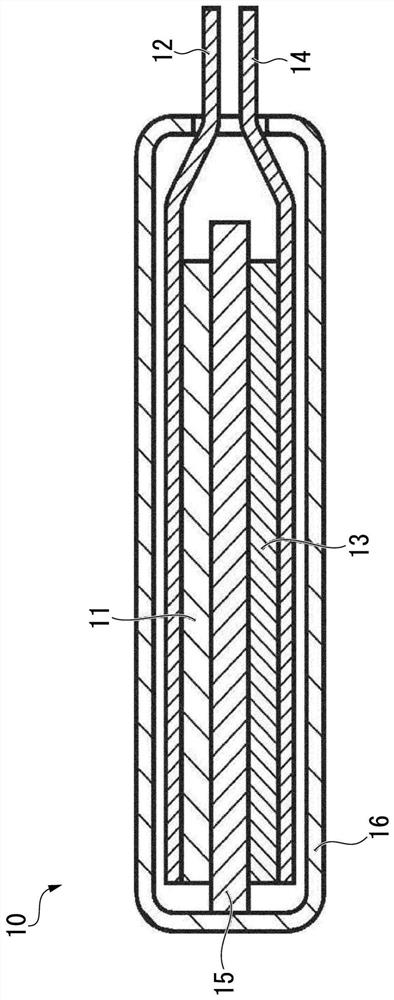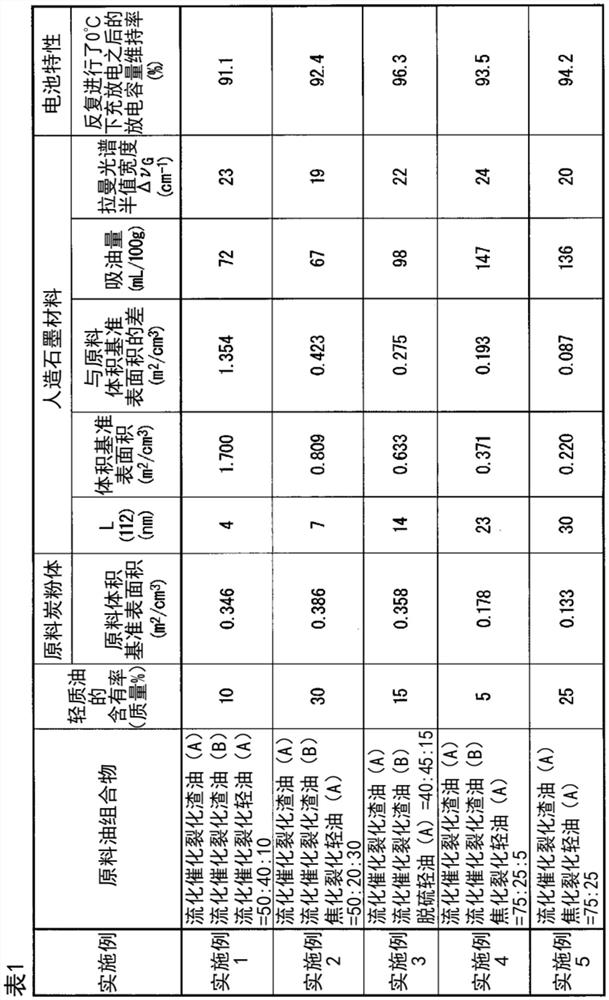Synthetic graphite material, synthetic graphite material production method, negative electrode for lithium ion secondary battery, and lithium ion secondary battery
A technology of artificial graphite and manufacturing method, applied in the direction of secondary battery, battery electrode, graphite, etc., can solve the problems of capacity deterioration, poor charging and discharging efficiency of positive electrode and negative electrode, etc., and achieve the effect that the discharge capacity is difficult to deteriorate
- Summary
- Abstract
- Description
- Claims
- Application Information
AI Technical Summary
Problems solved by technology
Method used
Image
Examples
Embodiment 1
[0185] Desulfurized vacuum light oil (sulfur content 500 mass ppm, density at 15°C: 0.88 g / cm 3 ) was subjected to fluid catalytic cracking to obtain a fluid catalytic cracking residue (hereinafter referred to as "fluid catalytic cracking residue (A)"). The obtained fluid catalytic cracking residue (A) had an initial boiling point of 200°C, a sulfur content of 0.2% by mass, a nitrogen content of 0.1% by mass, and an aromatic content of 65% by mass.
[0186] Next, desulfurized vacuum light oil (sulfur content 500 mass ppm, density at 15°C: 0.88 g / cm 3 ) was subjected to fluid catalytic cracking to obtain light cycle oil (hereinafter referred to as "fluid catalytic cracked light oil (A)"). The obtained fluid catalytic cracking light oil (A) had an initial boiling point of 180° C., an end boiling point of 350° C., an asphaltenes content of 0% by mass, a saturated content of 47% by mass, and an aromatic content of 53% by volume.
[0187]In addition, hydrodesulfurization of atmos...
Embodiment 2
[0217] Decomposed light oil (sulfur content 0.2% by mass, density at 15°C 0.92 g / cm3) obtained in the delayed coking process as light oil 3 , saturated components 36% by volume, aromatic components 64% by volume, asphaltene components 0% by mass, initial boiling point 220°C, final boiling point 340°C (hereinafter referred to as "coking cracked light oil (A)) and heavy oil Fluid catalytic cracking residue (A) and fluid catalytic cracking residue (B) are mixed in a ratio of 30:50:20 in mass ratio to obtain the stock oil composition of Example 2. The stock oil of Example 2 Table 1 shows the content of light oil in the composition.
[0218] The raw material oil composition of Example 2 was subjected to coking treatment in the same manner as in Example 1 to obtain a raw coke composition.
[0219] The obtained raw coke composition was pulverized with a hammer mill so that the average particle diameter measured by a laser diffraction particle size distribution analyzer became 18.2 μ...
Embodiment 3
[0226] The light oil obtained by the light oil desulfurization device, that is, the desulfurized light oil (density at 15°C is 0.90g / cm 3 , aromatic component 25% by volume, asphaltene component 0% by mass, initial boiling point 180°C, final boiling point 350°C (hereinafter referred to as "desulfurized light oil (A)) and fluid catalytic cracking residue ( A) and fluid catalytic cracking residue (B) are mixed in a ratio of 15:40:45 in mass ratio to obtain the stock oil composition of Example 3. The light oil in the stock oil composition of Example 3 The content rate of is shown in Table 1.
[0227] In the same manner as in Example 1, the raw material oil composition of Example 3 was subjected to a coking treatment to obtain a raw coke composition.
[0228] The obtained raw coke composition was pulverized with a hammer mill so that the average particle diameter measured by a laser diffraction particle size distribution analyzer became 19.6 μm, thereby obtaining a raw coke powde...
PUM
| Property | Measurement | Unit |
|---|---|---|
| oil absorption | aaaaa | aaaaa |
| density | aaaaa | aaaaa |
| particle diameter | aaaaa | aaaaa |
Abstract
Description
Claims
Application Information
 Login to View More
Login to View More - R&D
- Intellectual Property
- Life Sciences
- Materials
- Tech Scout
- Unparalleled Data Quality
- Higher Quality Content
- 60% Fewer Hallucinations
Browse by: Latest US Patents, China's latest patents, Technical Efficacy Thesaurus, Application Domain, Technology Topic, Popular Technical Reports.
© 2025 PatSnap. All rights reserved.Legal|Privacy policy|Modern Slavery Act Transparency Statement|Sitemap|About US| Contact US: help@patsnap.com



